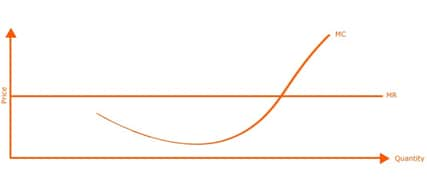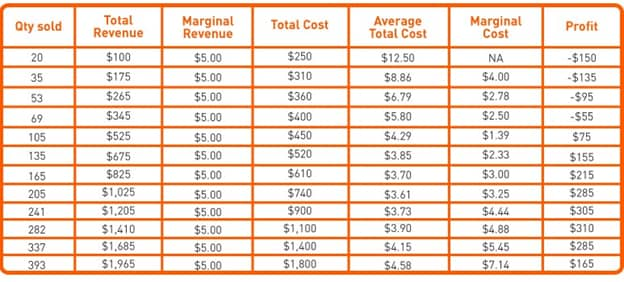
Increasing sales don’t necessarily mean increased profit. To take your business to next level you need to ensure you earn good profit. Here’s how to calculate costs and revenue to ensure you get the best profit margins possible.
What is Marginal Cost?
Marginal Cost (MC) is an increase of costs due to increasing production or capacity. In the start Marginal Cost is often high, because your basic overheads and labour costs are distributed over low quantities of orders served.
As serving quantity increases, fixed costs such as overheads and labour are divided by larger quantities of the orders prepared, and your Marginal Cost starts to decrease.
However, your cooking capacity will reach a point where new investments are required. For example, you might need to hire more people or invest in more equipment or a new kitchen to produce a higher volume. At this point, your Marginal Cost will increase again. This is why it is important for you to maintain the cooking capacity where your revenue is maximized and your Marginal Cost is less than your increase in revenue. At this level, profits are maximized.
What is Total Revenue?
Total Revenue (TR) refers to your total sales. This is the amount you collect from selling a certain quantity of dishes.
What is Marginal Revenue?
Marginal Revenue (MR) is the revenue obtained from the last unit sold. For example, if you get Rs.500 from selling 100 chicken rice sets and you make Rs.505 from selling 101 chicken rice sets, your Marginal Revenue is Rs.5. This is calculated by taking the change in Total Revenue divided by the change in quantity.
MR (Marginal Revenue) = Change in TR (Total Revenue) / Change in Quantity
What is Average Total Cost?
The Average Total Cost or Average Cost, as the name suggests, is how much it costs to produce a single serving of menu item. This is different from Marginal Costs, which refers to the change in production cost per serving, as per the last unit produced.
Applying the terms
It is important to know the terms above because they help you understand simple economic concepts that professionals use to derive optimal prices for maximising profits. We’ll start with this example:

To maximise profits, operators should produce at quantities where:
Marginal Cost = Marginal Revenue (MC = MR)
When MC > MR, the cost to produce an additional unit is more than the extra revenue generated. For example:
If the restaurant sells a quantity of 105 chicken rice sets, his MC (Rs.1.39) is much smaller than his MR (Rs.5). At this production level, his TR is Rs.525 while his TC is Rs.450. This means his profit is Rs.75.
However, if he produces a quantity of 282 chicken rice sets, his MC (Rs.4.88) is almost on par with his MR (Rs.5). At this production level, his TR is Rs.1,410, his TC is Rs.1,100 and his profits are Rs.310.